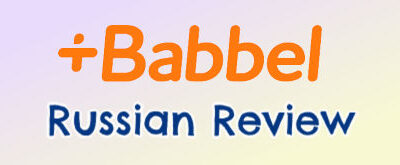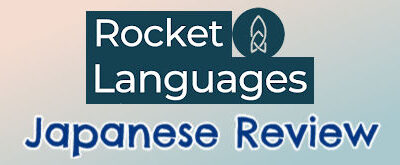Rosetta Stone, a leading language learning platform, offers an immersive approach to mastering Russian, a language known for its complexity and rich cultural heritage. This review explores the effectiveness of Rosetta Stone’s Russian program, focusing on its interactive lessons, intuitive design, and the challenges learners may face. Whether you’re a beginner or looking to refine your skills, this analysis will help you determine if Rosetta Stone is the right tool for your Russian language journey.
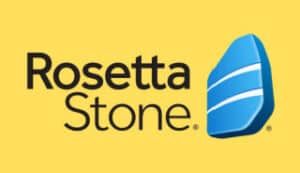
Rosetta Stone
- Multiple Subscription Options
- Money Back Guarantee
Pros
- Competitively priced subscription plans ($10-$15/mo)
- Effective learning method rooted in immersion
- Ideal Russian language program for visual learners
- Impressive speech recognition technology
- Tons of extra learning tools (e.g. short stories, on-demand videos)
Cons
- Picture-based lesson format can become repetitive
- Limited grammar instruction
How The Rosetta Stone Russian Program Works
When you first sign up for Rosetta Stone, you’ll answer a few questions to assess your initial Russian proficiency and your reasons for learning the language, among other details. Based on your responses, Rosetta Stone then creates a personalized weekly study plan.
However, beyond this semi-tailored approach, the Rosetta Stone Russian course is structured around 20 different units, each covering various themes such as dining, travel, and social life. Each unit contains four lessons, and within each lesson are several sections focused on different skills like pronunciation, vocabulary, reading, and writing.
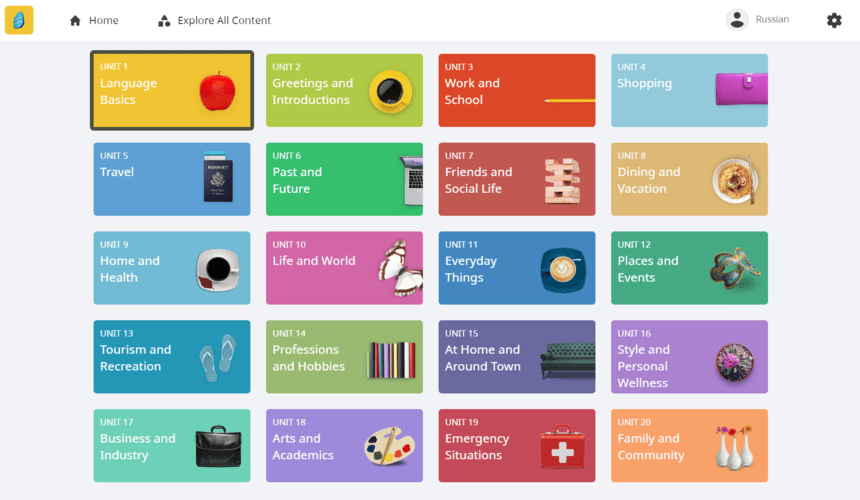
In essence, Rosetta Stone’s program is organized into thematic units, each with four lessons, and each lesson contains multiple sections. The individual sections take between 5 to 30 minutes to complete and rely heavily on image-based drills and exercises.
While we’ll delve into the pros and cons of Rosetta Stone’s lesson format later in this review, it’s important to note that completing all the sections in a single lesson typically takes around 50 to 60 minutes.
How Rosetta Stone Teaches Russian
Unlike most other language apps, Rosetta Stone’s Russian program is designed around full immersion, with minimal use of English during lessons. There’s no hand-holding; instead, the program relies on the idea that all communication should occur in the target language—Russian in this case—allowing learners to naturally develop understanding through context and reasoning.
In contrast to platforms like Pimsleur and Duolingo, Rosetta Stone immerses you in the language, compelling you to learn through inference and context. While this approach can be challenging, it is highly effective.
The Cost Of Rosetta Stone Russian
Fortunately, Rosetta Stone’s subscription plans are generally quite affordable. The company offers three options: two monthly subscriptions and a lifetime package.
The monthly plans typically range from $10 to $15 per month, while the lifetime package costs around $400. It’s worth noting that the lifetime plan includes access to all of Rosetta Stone’s languages, not just Russian (in case you are interested in learning another language such as Italian or French).
However, these prices are often reduced thanks to frequent sales and promotions. In most cases, you can expect discounts of at least 50% or more, similar to the deals offered by Babbel. After discounts, our team has seen monthly subscriptions drop to around $8 to $12, and the lifetime package reduced to $150-$200, making Rosetta Stone more affordable than competitors like Pimsleur and Rocket Languages.
Pros Explained
Now that you have some background information about Rosetta Stone in terms of learning method and cost, let’s discuss the strengths of their Russian language course.
Focus On Immersion
Our team was particularly impressed with the immersive learning approach that the Rosetta Stone Russian program utilizes.
While it can be challenging and somewhat frustrating at first, we believe that language immersion ultimately accelerates learning and fosters a deeper understanding of the language.
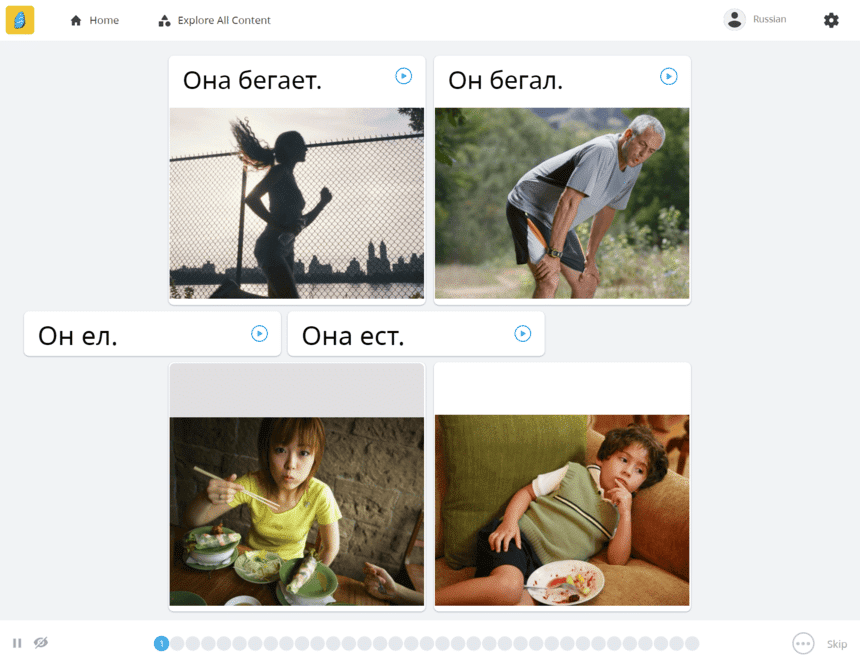
Instead of simply memorizing information presented in English, this method proves to be far more effective.
Consider how children acquire language—they do so gradually by absorbing it from a fully immersive environment. Our brains are naturally designed to recognize patterns, decode clues, and derive meaning from context, which is the foundation of the Rosetta Stone curriculum.
Although this approach can be tough, especially for beginners, we have to acknowledge that Rosetta Stone’s method is highly effective in the long term.
Good Fit For Visual Learners
Rosetta Stone is a fantastic choice for visual learners—no doubt about it. As we mentioned earlier, almost every drill and exercise in their lessons incorporates some type of image or graphic. In fact, it’s the most visually oriented language program we’ve come across so far. So, if you learn best through visuals rather than audio or experiential methods, Rosetta Stone should align well with your learning preferences.
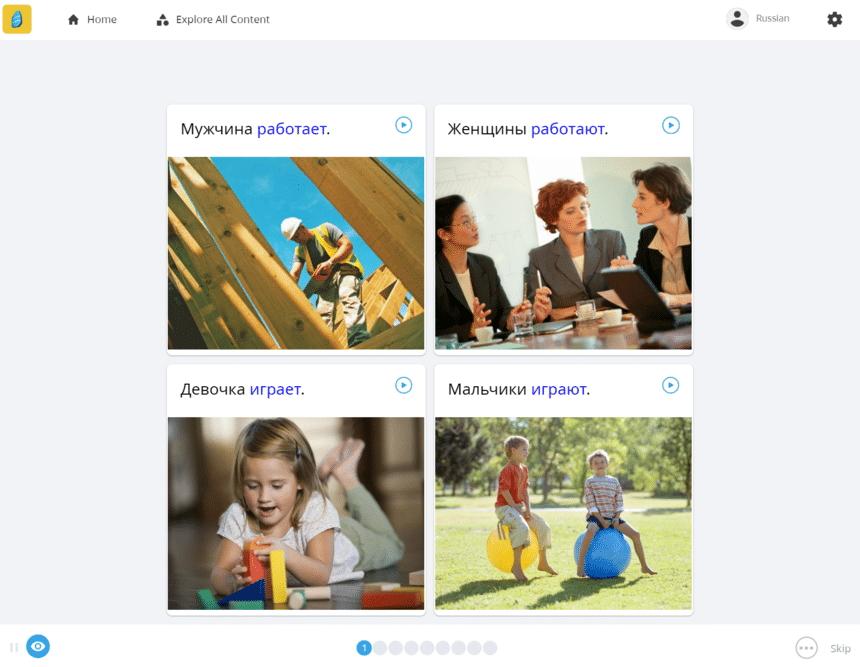
On the other hand, if you favor video-based lessons over Rosetta’s image-driven approach, you might want to explore Lingopie. Alternatively, for those who prefer audio learning, the Rocket Russian course would be an excellent option.
Impressive Speech Technology
Next, we’d like to highlight Rosetta Stone’s TruAccent technology, the speech recognition software that the company has meticulously developed over the years.
As you work through verbal exercises, the TruAccent software offers immediate and precise feedback on your pronunciation. Having tested more than a dozen different language programs, we consider Rosetta Stone’s TruAccent to be one of the top speech recognition tools available.
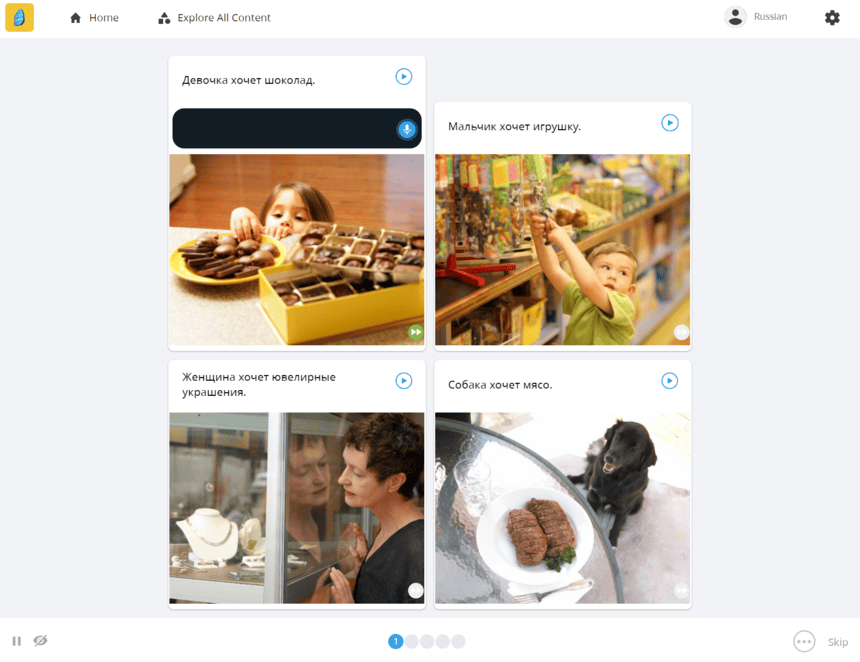
The software integrates smoothly into the lessons, is user-friendly, and consistently delivers accurate feedback—something that sets it apart from the voice recognition tools used by other language learning platforms.
In short, when it comes to helping users improve their pronunciation, Rosetta Stone really excels.
Additional Learning Resources
Rosetta Stone offers a variety of learning tools beyond their core curriculum, such as live sessions with Russian instructors, audio companions, short stories, and even a helpful alphabet tool.
Among these, I find the short stories particularly engaging. They provide a refreshing break from the standard lessons, offering a different way to practice. You listen as a Russian narrator reads the story aloud, much like a parent reading to a child. Then, you can reinforce your learning by reading the story aloud yourself, which is great for honing your pronunciation.
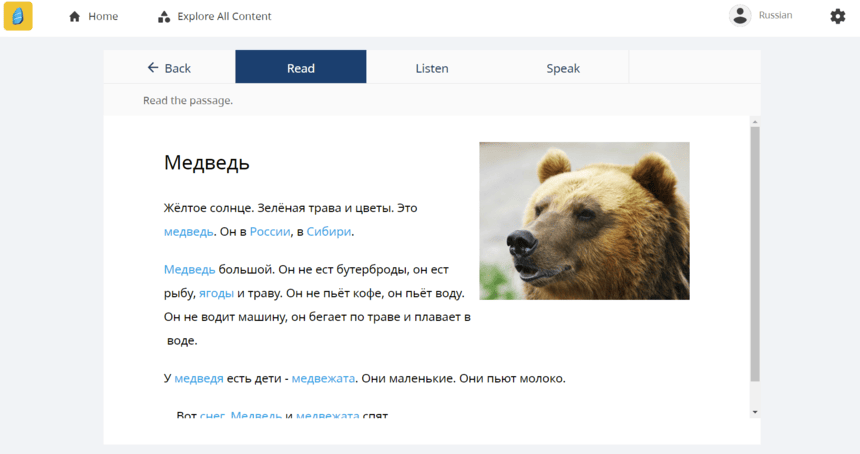
In my opinion, these stories are a fantastic method for enhancing both your receptive (reading and listening) and productive (speaking) language skills.
Cons Explained
Now that we’v discussed the positives, it’s only fair we discuss the negatives as well. Here are a few reasons why Rosetta Stone may not be a good fit for your learning style and preferences.
Lessons Can Become Monotonous
It’s hard to deny that Rosetta Stone’s lessons can become repetitive after a while.
The program relies heavily on the same picture-based exercises throughout, which doesn’t offer the kind of variety you might find in courses like Pimsleur or Babbel.
So, if you tend to lose focus or get bored easily, Rosetta Stone might not be the ideal choice for you. However, don’t forget that you can always mix things up by using the additional resources we discussed earlier to keep your learning experience fresh.
Immersion Has Its Downfalls
Another point to consider is that Rosetta Stone doesn’t provide straightforward grammar explanations or definitions. Instead, they stick to their immersive teaching method, where grammar is learned intuitively. So, you won’t be memorizing rules or filling out conjugation tables like you might with other language apps such as Duolingo or Rocket Languages.
This approach might not work for everyone. Some people prefer being given clear, concise grammar rules and tables to quickly understand key concepts.
However, Rosetta Stone takes a different path, allowing you to immerse yourself in the Russian language until you start recognizing patterns and correct syntax on your own. Whether this is a plus or minus really depends on your personal learning preference.
Verbal Practice Is Limited
Although we recognize the value of Rosetta Stone’s TruAccent speech software, we feel that the verbal practice exercises could be more comprehensive.
Currently, the exercises mainly involve listening to and repeating phrases, which is useful for honing pronunciation but doesn’t quite prepare you for using the language in real-time situations.
It would be beneficial to have more opportunities for on-the-spot thinking and spontaneous language use, similar to the mock conversations offered by Pimsleur or Rocket Languages. We believe this kind of practice would accelerate your ability to engage in basic conversations more quickly.
Verdict: Is Rosetta Stone Russian Worth It?
After extensive use and evaluation of the Rosetta Stone Russian course, the answer is generally yes. Rosetta Stone offers reasonably priced subscription plans and employs an immersive, visually-driven method that works well for visual learners. The program’s diverse range of additional learning tools, such as its TruAccent speech technology and interactive exercises, further enriches the learning experience.
The only scenarios where I might suggest looking elsewhere are if you’re primarily an auditory or tactile learner. For those who benefit from hands-on or auditory approaches, other programs might offer more suitable methods. Overall though, for most learners, Rosetta Stone stands out as a strong and effective option for mastering Russian.
👉 Read Next: Best Apps To Learn Russian
Signing-up for a Rosetta Stone subscription will typically set you back about $10 to $15 each month. If you decide on the lifetime plan, expect to pay roughly $400. It’s worth noting that Rosetta Stone frequently provides sales and discounts though, often ranging between 40% and 50% off.
Following our evaluation of the course, we found that the Rosetta Stone program is highly effective for learning Russian. Its design is particularly advantageous for visual learners, given how the lessons are structured.



